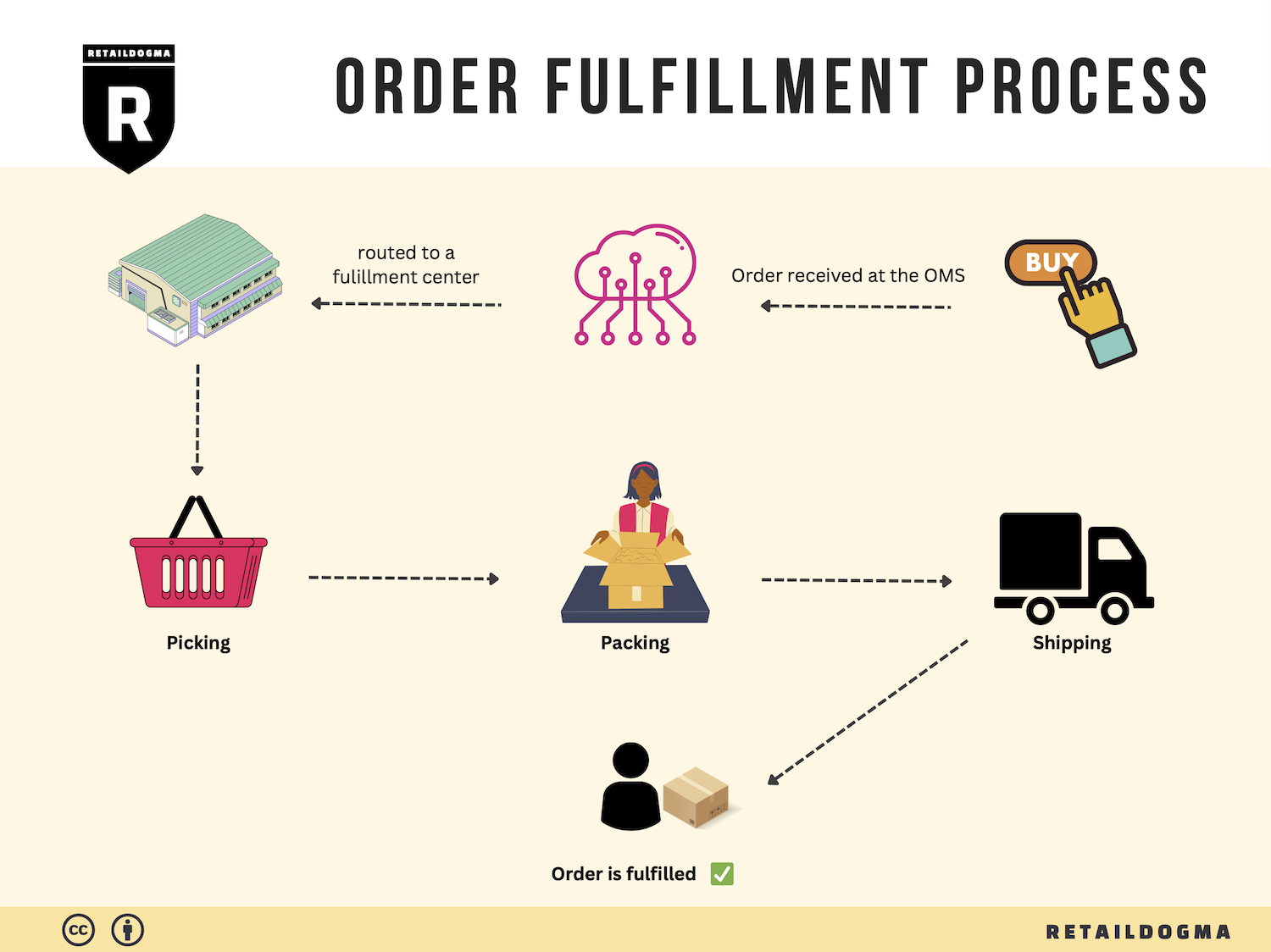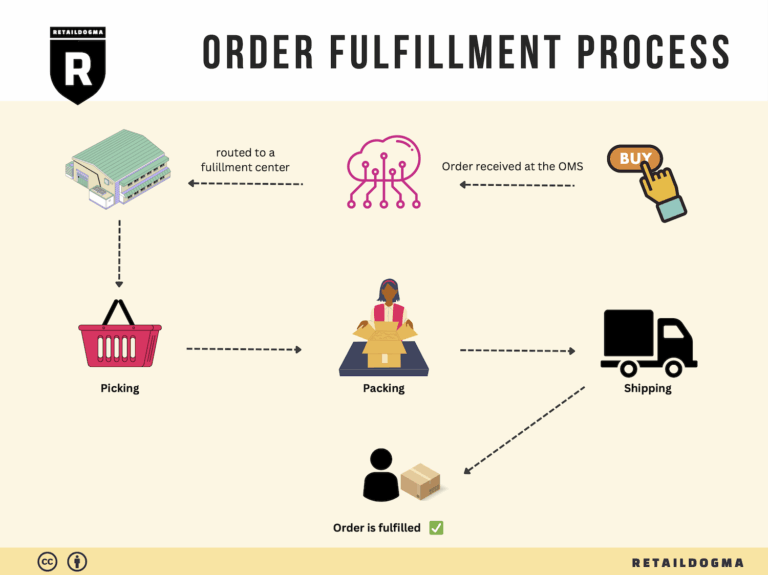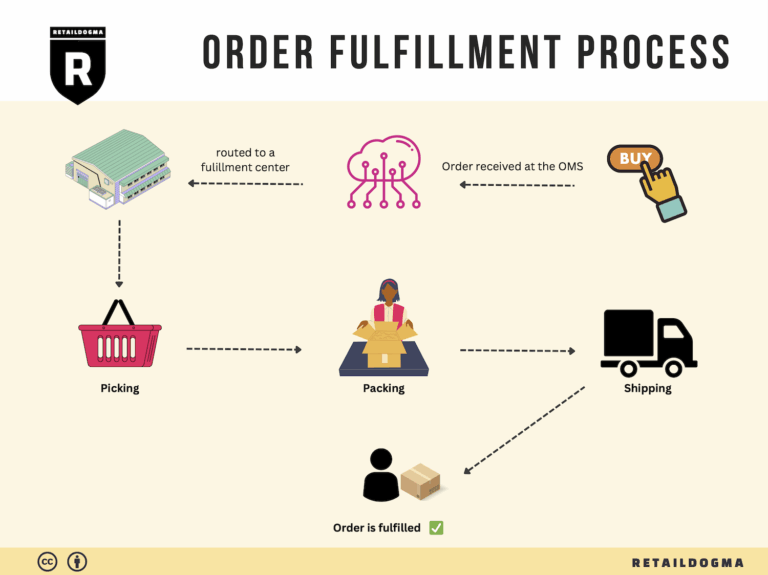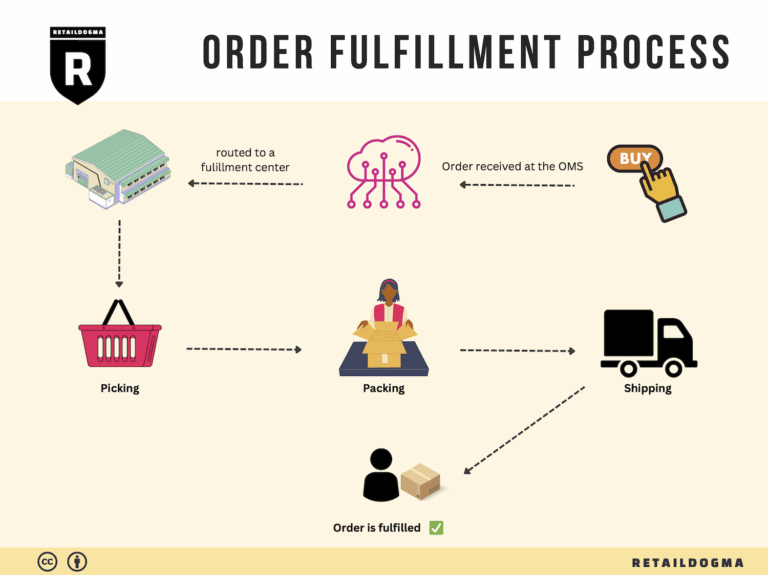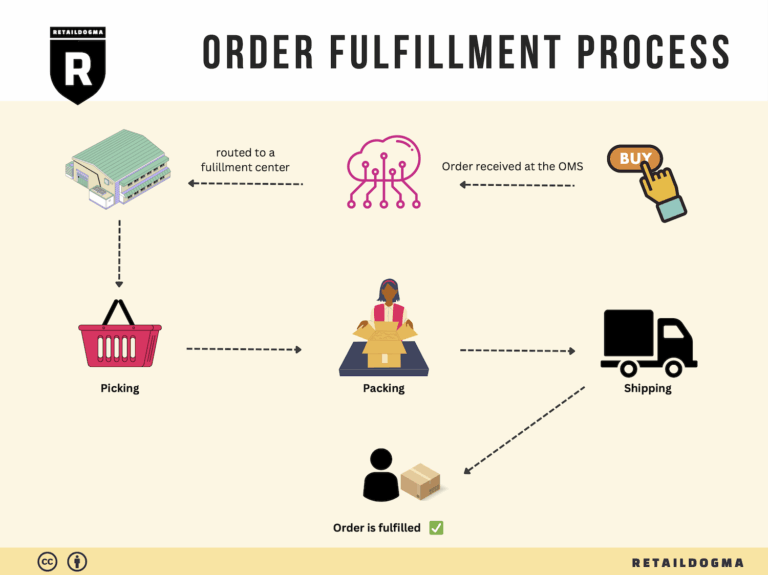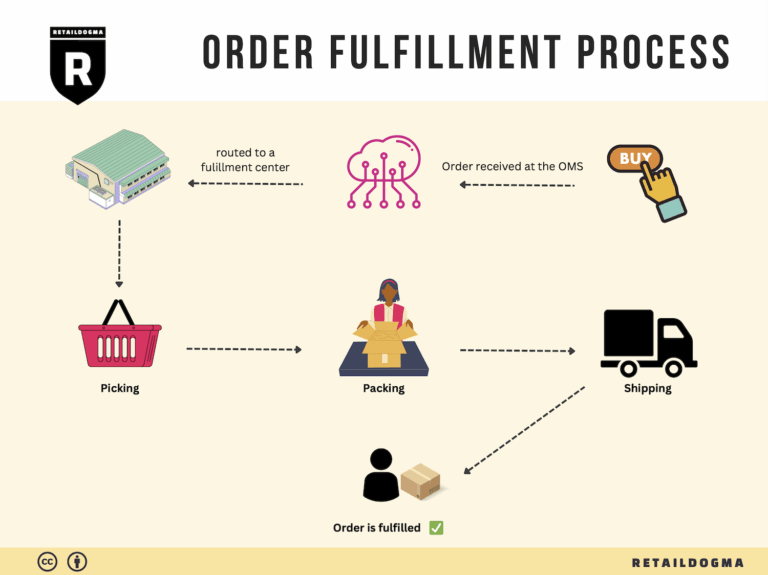Ecommerce Fulfillment Services: The Ultimate Guide (2025)
What is E-commerce Fulfillment? An Introduction for Growing Businesses
Understanding the Challenges of E-commerce Fulfillment
As an e-commerce business owner, you may find yourself grappling with the complexities of packing and shipping orders. Initially, the excitement of fulfilling customer orders can quickly turn into a daunting task as your sales grow. The process of getting a product from your inventory to your customer’s doorstep can become overwhelming, leading to potential delays, errors, and dissatisfied customers. This is where the concept of e-commerce fulfillment comes into play.
What is E-commerce Fulfillment?
At its core, e-commerce fulfillment is the entire process of receiving, processing, and delivering an order to a customer. This includes inventory management, order picking, packing, shipping, and even handling returns. For growing businesses, mastering this process is crucial to maintaining customer satisfaction and scaling operations efficiently.
What This Guide Will Cover
In this guide, we will explore various fulfillment models that can streamline your logistics and enhance your operational efficiency. Key models include:
- Third-Party Logistics (3PL): Outsourcing your fulfillment needs to specialized providers who handle storage, packing, and shipping.
- Fulfillment by Amazon (FBA): Utilizing Amazon’s vast distribution network to reach customers quickly while offloading many logistical responsibilities.
We will also delve into core services associated with e-commerce fulfillment, such as inventory storage, order management, packaging, and shipping options.
Choosing the right fulfillment partner is critical to your success. This guide will provide insights on how to evaluate potential partners based on their capabilities, technology, and customer service. Additionally, we will cover pricing models to help you understand the costs involved in different fulfillment strategies and how to align them with your business goals.
Empowering Your Business Decisions
Our goal with this guide is to empower you with the knowledge needed to make informed decisions about your logistics and fulfillment strategy. By understanding the intricacies of e-commerce fulfillment, you can identify the right solutions that not only reduce operational burdens but also enhance your customer experience. Whether you are considering outsourcing your fulfillment or looking to optimize your current processes, this guide aims to be a valuable resource in your journey toward scalable success.
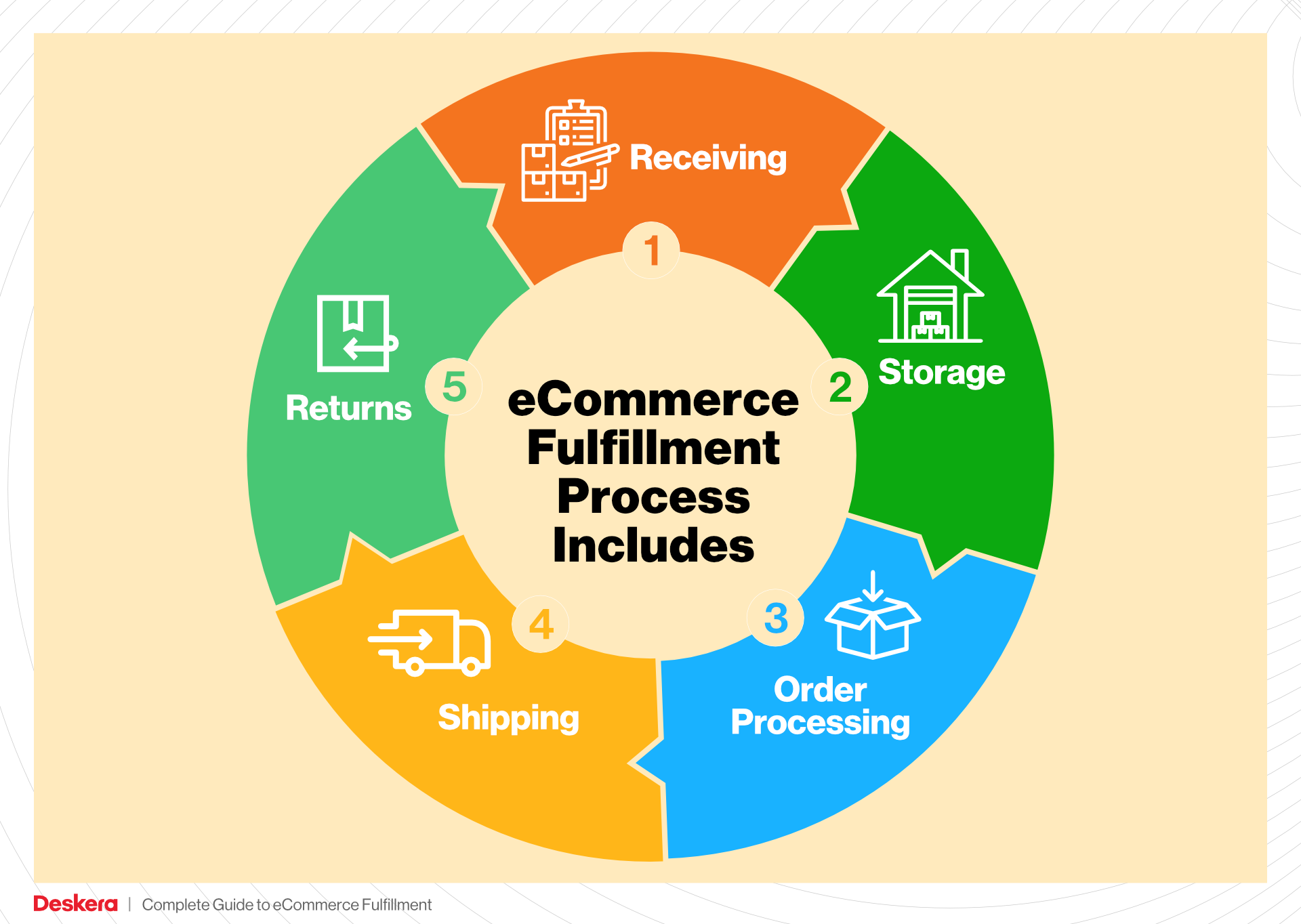
What You’ll Learn In This Guide
- What is E-commerce Fulfillment? An Introduction for Growing Businesses
- The Order Fulfillment Process: From ‘Buy’ Button to Customer’s Door
- Comparing Fulfillment Models: In-House vs. 3PL vs. Dropshipping
- A Deep Dive into Amazon FBA: Pros, Cons, and Who It’s For
- Core Services Offered by Fulfillment Centers
- How to Choose a Fulfillment Partner: A 6-Point Checklist
- Understanding Fulfillment Pricing: A Breakdown of Common Fees
- Frequently Asked Questions (FAQs) about Fulfillment
- Conclusion: Is Outsourcing Fulfillment the Right Move for Your Business?
- Important Disclaimer
The Order Fulfillment Process: From ‘Buy’ Button to Customer’s Door
1. Receiving Inventory
The order fulfillment process begins with receiving inventory at the fulfillment center, such as Amazon’s GEG2 facility in Spokane Valley. When products arrive, they are unloaded from delivery trucks and carefully checked against purchase orders to ensure accuracy. This step is crucial for maintaining inventory integrity and preventing discrepancies that could affect order fulfillment later.
During this stage, products are assigned unique identifiers, commonly referred to as Stock Keeping Units (SKUs). These SKUs facilitate tracking and management of inventory levels. Properly receiving inventory not only ensures that the right products are available for customer orders but also lays the groundwork for efficient storage and retrieval in subsequent steps.
2. Warehouse Storage
Once the inventory is received and verified, it is stored in designated locations within the warehouse. The GEG2 center, spanning 1.3 million square feet, utilizes various storage solutions, such as shelving and pallet racks, to maximize space and accessibility for larger items.
Effective warehouse storage is vital for operational efficiency. By implementing a systematic approach, such as categorizing products by type or popularity, businesses can significantly reduce the time needed to locate items during order picking. A critical term associated with this step is “location codes,” which help warehouse staff quickly identify where specific SKUs are stored, thus enhancing the speed and accuracy of the fulfillment process.
3. Order Picking
When a customer places an order, the fulfillment process transitions to order picking. Warehouse staff receive pick lists that detail the items required for each order. These lists may be generated through an automated system that prioritizes orders based on shipping deadlines or customer location.
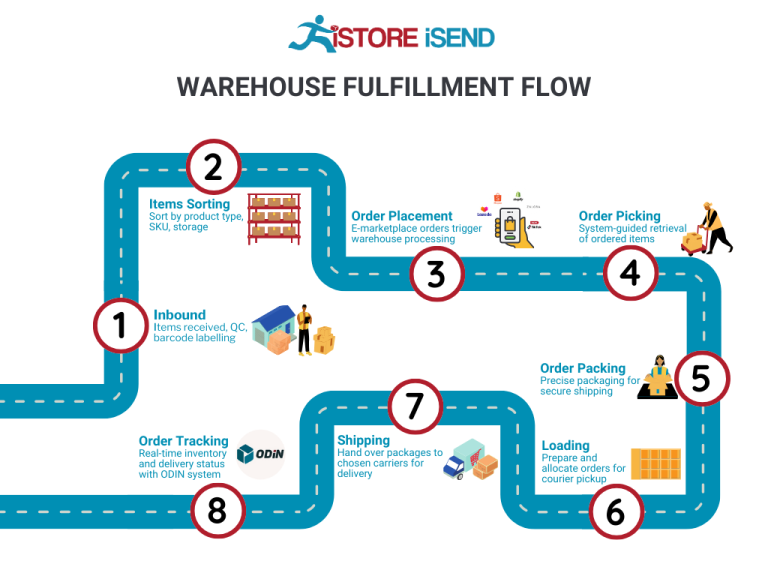
Order picking is a key component of the fulfillment process, directly impacting delivery speed and customer satisfaction. Efficient picking strategies, such as batch picking (where multiple orders are picked simultaneously) or wave picking (where orders are grouped based on shipping schedules), can optimize labor use and reduce the time spent in this phase. Utilizing technology, like handheld scanners, can also enhance accuracy by minimizing human error in item selection.
4. Order Packing
After items are picked, they move to the packing station, where they are prepared for shipment. In this stage, items are carefully packed into appropriate shipping materials to ensure they arrive at the customer’s door in perfect condition. This includes selecting the right box size, adding protective padding, and including packing slips or invoices.
Packing is crucial not only for protecting products but also for optimizing shipping costs. A well-packed order reduces the risk of damage during transit and can lead to more efficient use of shipping space. A relevant term here is “dimensional weight,” which shipping carriers use to calculate shipping costs based on the package size rather than weight alone. Understanding this concept helps businesses choose packing materials wisely, ultimately impacting their bottom line.
5. Shipping & Delivery
The final step in the order fulfillment process is shipping and delivery. Once packed, orders are labeled and prepared for dispatch, often through a network of logistics partners or in-house delivery services. The GEG2 fulfillment center, strategically located in Spokane Valley, allows for efficient distribution to various regions.
Shipping and delivery play a pivotal role in customer satisfaction and retention. Timely delivery is often a significant factor in the overall shopping experience. Businesses should utilize tracking systems that provide customers with real-time updates on their order status, enhancing transparency and trust. A key term associated with this stage is “last-mile delivery,” which refers to the final leg of the shipping journey from a distribution center to the customer’s doorstep. Efficient last-mile delivery strategies can greatly improve delivery times and reduce costs, making it a critical focus area for scaling e-commerce operations.
By understanding and optimizing each step of the order fulfillment process, businesses can enhance their operational efficiency, reduce costs, and ultimately improve customer satisfaction.
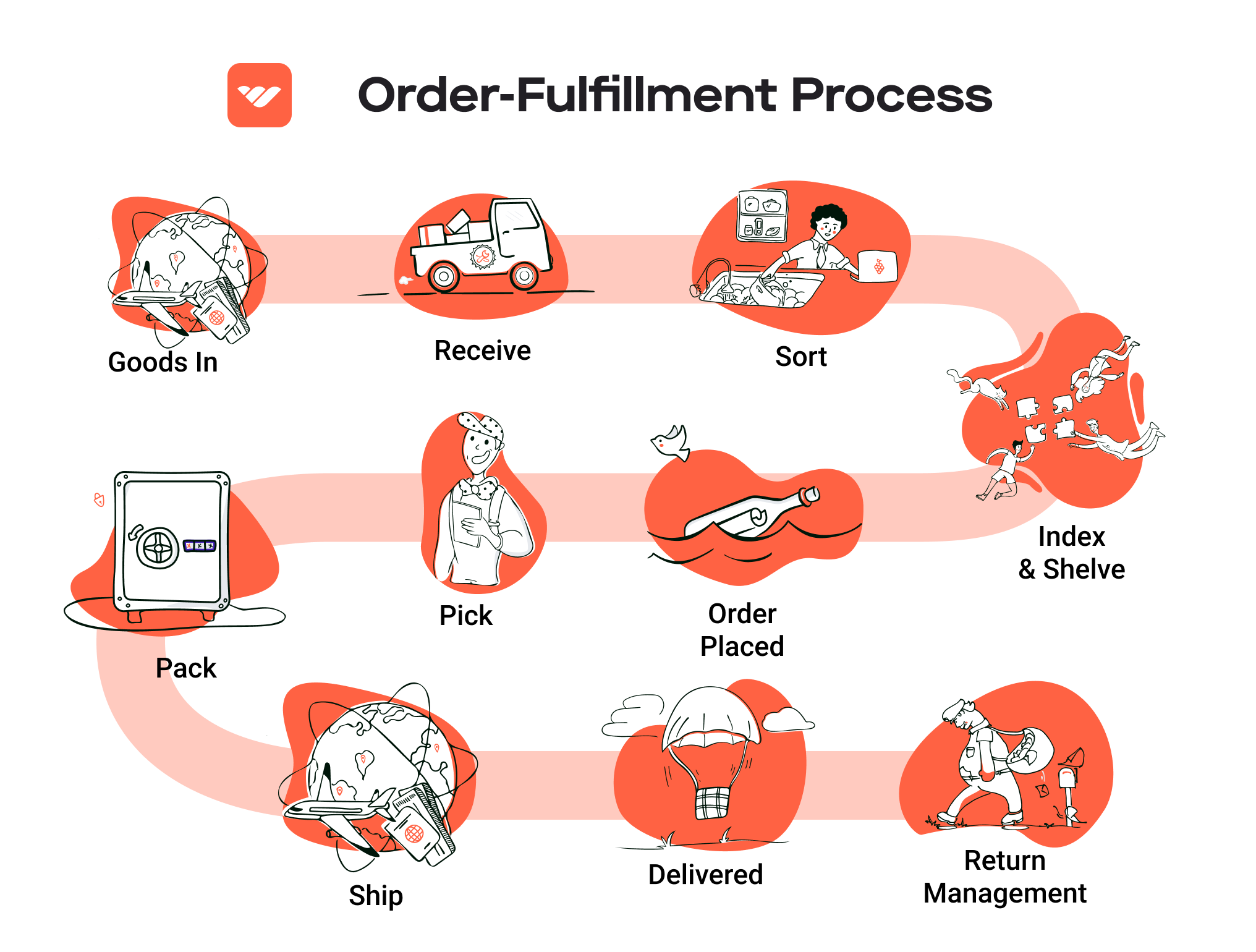
Comparing Fulfillment Models: In-House vs. 3PL vs. Dropshipping
Fulfillment Model Comparison
| Model | Who Handles Inventory | Best For (Business Stage) | Key Advantage | Key Disadvantage |
|---|---|---|---|---|
| In-House Fulfillment | The business itself | Established businesses | Full control over inventory and operations | High overhead costs and resource allocation |
| Third-Party Logistics (3PL) | An external logistics provider | Growing businesses | Scalable solutions and expertise in logistics | Less control over inventory and potential delays |
| Dropshipping | Suppliers or manufacturers | Startups or low-risk ventures | Minimal upfront investment and risk | Lower profit margins and reliance on suppliers |
In-House Fulfillment
In-house fulfillment involves managing the entire inventory and logistics process within the business itself. This model is typically favored by established businesses that have the resources and infrastructure to handle storage, picking, packing, and shipping orders. One of the primary advantages of in-house fulfillment is the level of control it provides. Businesses can implement their own processes, ensure product quality, and directly manage customer service. This model also allows for faster response times to inventory changes and customer demands. However, the downsides include significant overhead costs associated with warehousing, staffing, and maintaining fulfillment infrastructure. Additionally, businesses must invest in technology and systems to manage inventory effectively, which can be a barrier for some.
Third-Party Logistics (3PL)
Third-party logistics (3PL) is a fulfillment model where businesses outsource their logistics operations to an external provider. This is an attractive option for growing businesses that need to scale their operations without the burden of managing logistics internally. 3PL providers specialize in warehousing, order fulfillment, and distribution, which allows businesses to leverage their expertise and resources. The key advantage of using a 3PL is scalability; as demand fluctuates, businesses can easily adjust their logistics requirements without the need for significant capital investment. However, the reliance on an external provider can lead to less control over inventory management and potential delays in shipping, which can impact customer satisfaction. Businesses must also ensure they choose a reputable 3PL partner that aligns with their operational goals and customer expectations.
Dropshipping
Dropshipping is a fulfillment model where retailers do not hold inventory but instead rely on suppliers or manufacturers to ship products directly to customers. This model is particularly appealing for startups or businesses looking to minimize upfront investment and risk. By not having to manage inventory, businesses can focus on marketing and customer acquisition, making dropshipping an attractive option for those testing new products or markets. The key advantage is the minimal financial commitment, as businesses only purchase products after they have been sold. However, dropshipping also presents challenges, including lower profit margins due to reliance on suppliers, and a lack of control over inventory and shipping times. Delays and stock shortages from suppliers can lead to customer dissatisfaction, making it crucial for dropshippers to establish strong relationships with reliable suppliers.
Conclusion
When choosing a fulfillment model, e-commerce businesses must weigh the advantages and disadvantages of each approach against their operational capabilities, growth stage, and customer expectations. In-house fulfillment offers control but comes with higher costs; 3PL provides scalability but may lead to reduced control; and dropshipping minimizes risk but can result in lower margins. Assessing these factors will help businesses make informed decisions that align with their strategic goals and growth trajectories.
A Deep Dive into Amazon FBA: Pros, Cons, and Who It’s For
Understanding Fulfillment by Amazon (FBA)
Fulfillment by Amazon (FBA) is a service offered by Amazon that allows e-commerce sellers to store their products in Amazon’s fulfillment centers. Amazon takes care of storage, packaging, and shipping of these products on behalf of the sellers. This service not only provides logistics support but also offers a powerful platform for sellers to reach a vast audience, leveraging Amazon’s reputation and infrastructure.
How FBA Works
-
Product Listing: Sellers begin by creating a product listing on Amazon. They can choose to sell either new or used items.
-
Shipping to Amazon: Once the listing is created, sellers ship their products to one or more of Amazon’s fulfillment centers. Amazon provides specific guidelines regarding packaging and labeling that sellers must follow.
-
Storage: Products are stored in Amazon’s warehouses until they are sold. Amazon manages the inventory levels and informs sellers when it’s time to replenish stock.
-
Order Processing: When a customer orders a product, Amazon picks, packs, and ships the item directly to the customer. This process is streamlined, ensuring fast delivery.
-
Customer Service and Returns: Amazon also handles customer service inquiries and returns for FBA products, allowing sellers to focus on other aspects of their business.
Pros of Fulfillment by Amazon
-
Prime Eligibility: Products fulfilled by Amazon are eligible for Amazon Prime, which attracts millions of loyal customers who prefer fast and free shipping. This can significantly boost sales as Prime members are more likely to purchase items that come with Prime benefits.
-
Customer Trust: Amazon is a trusted brand. By utilizing FBA, sellers can leverage Amazon’s reputation, making customers more likely to purchase their products due to the perceived reliability and quality assurance that comes with Amazon’s brand.
-
Multi-Channel Fulfillment: FBA allows sellers to fulfill orders from other sales channels using Amazon’s infrastructure. This means that whether you sell on your own website, eBay, or other platforms, you can use FBA to manage your logistics, simplifying operations.
-
Scalability: FBA can easily scale with your business. As your sales grow, Amazon can handle the increased order volume without the need for additional investment in warehouse space or logistics.
-
Time-Saving: By outsourcing logistics to Amazon, sellers can focus on marketing, product development, and customer engagement rather than the complexities of shipping and fulfillment.
Cons of Fulfillment by Amazon
-
High Fees: FBA comes with various fees, including storage fees for inventory held in Amazon’s warehouses and fulfillment fees based on the size and weight of the products. These costs can eat into profit margins, especially for low-priced items.
-
Strict Inventory Rules: Amazon has strict policies regarding inventory management. Sellers must comply with Amazon’s guidelines on product conditions, packaging, and labeling. Failure to comply can lead to penalties or even account suspension.
-
Commingling Risks: FBA products may be commingled, meaning that sellers’ inventory may be mixed with that of other sellers. This can create issues if customers return a product that does not match the seller’s quality standards or if there are disputes regarding counterfeit products.
-
Loss of Control: Once products are sent to Amazon’s fulfillment centers, sellers lose some control over their inventory and fulfillment processes. This can be challenging for brands that prioritize customer experience and branding.
-
Potential for Account Suspension: If sellers do not adhere to Amazon’s policies, there is a risk of account suspension, which can halt sales and disrupt business operations.
Who is FBA Best For?
Fulfillment by Amazon is particularly beneficial for:
-
Small to Medium-Sized Businesses: Businesses that lack the resources to manage their logistics can benefit from the scalability and efficiency that FBA offers.
-
Entrepreneurs Looking to Scale: Sellers who want to focus on growth and marketing rather than logistics can use FBA to manage fulfillment seamlessly.
-
Sellers with Diverse Product Lines: Businesses offering multiple products, especially those with varying sizes and weights, can leverage Amazon’s infrastructure to simplify storage and shipping.
-
Brands Seeking Brand Recognition: New or small brands looking to establish credibility and trust can take advantage of Amazon’s reputation, making FBA an appealing option.
-
Multi-Channel Sellers: E-commerce businesses selling across multiple platforms can benefit from using FBA to streamline their order fulfillment across various channels.
In conclusion, while Fulfillment by Amazon offers a wealth of advantages that can significantly enhance an e-commerce business’s reach and efficiency, it is crucial for sellers to carefully consider the associated costs and potential challenges. By weighing the pros and cons, e-commerce entrepreneurs can make informed decisions on whether FBA aligns with their business strategy and goals.
Core Services Offered by Fulfillment Centers
Inventory Management & Warehousing
Fulfillment centers, such as Amazon GEG2, provide comprehensive inventory management and warehousing solutions that are crucial for e-commerce businesses. These facilities are equipped with advanced inventory tracking systems that allow for real-time monitoring of stock levels. By utilizing barcoding and RFID technology, fulfillment centers can efficiently manage large volumes of products and ensure that the right items are available when needed.
The benefits of effective inventory management are manifold. First, it minimizes the risk of stockouts or overstock situations, which can significantly impact sales and cash flow. By maintaining optimal inventory levels, businesses can respond swiftly to customer demand without tying up excessive capital in unsold goods. Furthermore, accurate inventory data enables e-commerce businesses to make informed purchasing decisions, ultimately leading to better supplier negotiations and cost savings.
Pick and Pack Services
Pick and pack services are a cornerstone of fulfillment center operations. This process involves selecting items from the warehouse shelves based on incoming orders and packaging them for shipment. Fulfillment centers like GEG2 employ sophisticated order management systems that streamline this process, ensuring that items are picked accurately and efficiently.
The advantages of utilizing pick and pack services are significant for e-commerce businesses. First, it enhances order accuracy, reducing the likelihood of returns and customer dissatisfaction. Fast and efficient packing also accelerates shipping times, which is critical in an era where consumers expect rapid delivery. By outsourcing this function to a fulfillment center, businesses can focus on scaling their operations and improving customer experiences rather than being bogged down by logistical challenges.
Kitting and Assembly
Kitting and assembly services involve the grouping of various products into ready-to-sell kits or the assembly of components into finished products. Fulfillment centers often offer these services to help e-commerce businesses create bundled offerings or customized products that cater to specific customer needs. This process can include anything from assembling gift sets to preparing subscription boxes.
The primary benefit of kitting and assembly is that it allows businesses to offer unique product combinations that can differentiate them in a crowded marketplace. It also simplifies the inventory process by reducing the number of individual SKUs (Stock Keeping Units) that need to be managed. Moreover, this service can lead to increased sales, as bundled products often present a more attractive offering to consumers, encouraging larger purchases and enhancing overall customer satisfaction.
Returns Management (Reverse Logistics)
Returns management, also known as reverse logistics, is a critical service offered by fulfillment centers. This process involves handling product returns from customers and reintegrating those products back into inventory or managing their disposal. A well-structured returns management system is essential for maintaining customer trust and satisfaction, as it provides a seamless experience for customers who may be dissatisfied with their purchases.
The benefits of effective returns management are substantial. For one, it helps e-commerce businesses recover lost revenue by efficiently processing returns and restocking items that can be resold. Moreover, a transparent and user-friendly returns process can enhance customer loyalty, as consumers are more likely to shop with a brand that offers hassle-free returns. Finally, insights gained from analyzing return data can inform product development and inventory decisions, helping businesses understand customer preferences and reduce future return rates.
Conclusion
In summary, fulfillment centers like Amazon GEG2 offer a suite of core services that are vital for e-commerce businesses aiming to scale their operations effectively. From inventory management and warehousing to pick and pack services, kitting and assembly, and returns management, these services not only streamline logistics but also enhance the overall customer experience. By leveraging the capabilities of fulfillment centers, e-commerce businesses can focus on growth and innovation, positioning themselves for long-term success in the competitive online marketplace.
How to Choose a Fulfillment Partner: A 6-Point Checklist
Location & Warehouse Network
Importance:
The geographical location of your fulfillment partner’s warehouses plays a critical role in shipping efficiency and cost-effectiveness. A partner with strategically positioned warehouses can significantly reduce shipping times and costs, enhancing customer satisfaction.
Questions to Ask:
– Where are your fulfillment centers located, and how do they align with my target markets?
– What is your average shipping time to various regions?
– How do you handle shipping logistics for international orders?
– Can you provide information on your network of carrier partnerships?
Technology & Integrations
Importance:
In today’s digital world, technology is crucial for streamlining operations. A fulfillment partner should offer robust technology platforms that integrate seamlessly with your e-commerce systems, allowing for real-time inventory management and order tracking.
Questions to Ask:
– What type of technology do you use for inventory management and order processing?
– Can your system integrate with popular e-commerce platforms like Shopify, WooCommerce, or Amazon?
– Do you provide real-time tracking for shipments, and how is this information communicated to customers?
– Are there any additional software costs associated with these integrations?
Specializations (e.g., cold storage, oversized items)
Importance:
Different businesses have unique product requirements. If you sell specialized items—such as perishables, oversized goods, or hazardous materials—your fulfillment partner should have the appropriate facilities and expertise to handle these products safely and efficiently.
Questions to Ask:
– Do you have specialized facilities for handling specific types of products (e.g., cold storage, oversized items)?
– What certifications or compliance measures do you have in place for handling specialized items?
– Can you accommodate seasonal fluctuations in product demand?
– How do you ensure the quality and safety of specialized products during storage and shipping?
Scalability & Capacity
Importance:
As your business grows, your fulfillment needs will evolve. A capable partner should not only accommodate your current volume but also have the infrastructure to scale alongside your growth. This includes having the capacity to handle spikes in demand during peak seasons.
Questions to Ask:
– What is your current capacity for handling orders, and how do you manage peak periods?
– How do you scale operations to accommodate rapid growth or seasonal fluctuations?
– Can you provide a case study of how you handled a client’s growth?
– What is your policy for onboarding new clients, and how quickly can you start fulfilling orders?
Pricing and Contracts
Importance:
Understanding the pricing structure and contract terms of your fulfillment partner is essential for budget management. Transparency in pricing can help avoid unexpected costs down the line, allowing you to better plan your financials.
Questions to Ask:
– Can you provide a detailed breakdown of your pricing model (e.g., storage fees, pick and pack fees, shipping costs)?
– Are there any hidden fees or long-term contracts that I should be aware of?
– What is your policy for price increases, and how often do they occur?
– Can you offer flexibility in your contracts, such as month-to-month agreements?
Customer Support & Reviews
Importance:
Reliable customer support is crucial for addressing issues quickly and maintaining operational efficiency. Furthermore, reviewing customer feedback can provide insights into the partner’s performance and reliability.
Questions to Ask:
– What is your process for handling customer inquiries and issues?
– How can I reach your support team, and what are your response times?
– Can you provide testimonials or case studies from current or previous clients?
– How do you handle disputes or issues that may arise during the fulfillment process?
Conclusion
Choosing the right fulfillment partner is a pivotal decision that can greatly affect your e-commerce operations and customer satisfaction. By systematically evaluating potential partners using this checklist, you can ensure that you select a fulfillment provider that aligns with your business goals and growth trajectory. Remember, a strategic partner will not only help you manage logistics but also enhance your overall customer experience, driving your business toward sustainable growth.
Understanding Fulfillment Pricing: A Breakdown of Common Fees
Initial Setup Fees
When partnering with a fulfillment center like Amazon GEG2, businesses often encounter initial setup fees. These fees are typically charged to cover the administrative costs of onboarding a new client. The fees can vary based on the complexity of the setup, which may include the integration of your e-commerce platform with the fulfillment center’s systems, inventory onboarding, and initial training sessions for your team.
For example, if you require special configurations in the warehouse management system or additional training for your staff, the initial setup fees could increase. It’s advisable to clarify what specific services are included in the setup fees to avoid unexpected costs.
Receiving Fees
Receiving fees are charged when your inventory arrives at the fulfillment center. This fee covers the labor and resources needed to unload, inspect, and store your products. Receiving fees can vary based on the type and volume of goods being delivered.
Typically, these fees are calculated on a per-unit basis or by the weight of the shipment. For instance, if you’re sending bulk items, the receiving fee might be lower per unit compared to smaller, individually packaged items. Understanding the specifics of how receiving fees are calculated can help you plan your inventory shipments more effectively.
Storage Fees (per pallet/bin)
Storage fees are incurred for keeping your inventory at the fulfillment center. These fees are usually assessed on a monthly basis and calculated based on the space your products occupy—commonly measured in pallets or bins.
For example, if your product takes up one pallet and the storage fee is $20 per pallet per month, you would pay $20 for that pallet. It’s essential to consider seasonal fluctuations in demand, as excess inventory during off-peak seasons can lead to increased storage costs. Some fulfillment centers may also charge additional fees for long-term storage, so it’s wise to regularly assess your inventory levels and turnover rates.
Pick & Pack Fees (per item/order)
Pick and pack fees are charged for the service of selecting items from the warehouse and packing them for shipment. These fees are typically calculated on a per-item or per-order basis.
For example, if your order consists of five items and the pick fee is $1 per item, you would be charged $5 for picking. Additionally, there may be a separate packing fee, which could be a flat rate or vary based on the complexity of the packaging required. Understanding the nuances of pick and pack fees can help you design your product offerings more effectively to minimize costs.
Shipping Fees
Shipping fees are among the most variable costs associated with fulfillment. These fees depend on multiple factors, including the shipping method (standard, expedited, etc.), package dimensions, weight, and destination.
Fulfillment centers like Amazon GEG2 often leverage their shipping volume to negotiate better rates with carriers, which can be passed on to you. It’s crucial to compare shipping options and understand how the fulfillment center calculates these fees—whether it’s by weight, dimensions, or a flat rate per shipment. By optimizing your packaging and choosing the right shipping methods, you can reduce these costs significantly.
Tips for Getting an Accurate Quote
-
Provide Detailed Inventory Information: When requesting a quote, be as specific as possible about your inventory types, volumes, and any special handling requirements.
-
Understand Your Shipping Needs: Clarify your shipping preferences, including speed and destination, as these will significantly impact the shipping fees.
-
Inquire About Additional Fees: Don’t hesitate to ask about any potential hidden fees, such as for long-term storage or returns processing, to avoid surprises later on.
-
Request a Breakdown: Ask the fulfillment center for a detailed breakdown of all fees associated with their services. This will help you understand where your costs are coming from and allow for better budgeting.
-
Review Service Level Agreements (SLAs): Ensure that the fulfillment center’s SLAs align with your business needs, particularly regarding order processing times and inventory accuracy.
By understanding these common fulfillment pricing models and how they are calculated, e-commerce business owners can make informed decisions that align with their operational goals and budget constraints.
Frequently Asked Questions (FAQs) about Fulfillment
1. What is Amazon GEG2?
Amazon GEG2 is a large fulfillment center located in Spokane Valley, Washington. Covering approximately 1.3 million square feet, it specializes in the storage and distribution of larger items, streamlining the process of order fulfillment for Amazon’s extensive customer base.
2. How does GEG2 differ from other Amazon fulfillment centers?
Unlike traditional fulfillment centers that may focus on smaller items, GEG2 is a non-sort facility designed specifically for larger products. This specialization allows for more efficient handling and shipping of bulkier goods, improving overall operational efficiency.
3. What services does the Amazon GEG2 fulfillment center provide?
Amazon GEG2 offers a variety of fulfillment services, including order processing, inventory management, and shipping for larger items. The center plays a crucial role in Amazon’s logistics network, ensuring timely delivery and customer satisfaction.
4. What is the difference between a warehouse and a fulfillment center?
A warehouse primarily focuses on storage, while a fulfillment center is designed to handle the entire process of order fulfillment, including picking, packing, and shipping products to customers. Fulfillment centers are typically integrated with e-commerce platforms to facilitate quick and efficient order processing.
5. What is a Third-Party Logistics Provider (3PL)?
A Third-Party Logistics Provider (3PL) is a company that offers outsourced logistics services, including warehousing, fulfillment, and transportation. Businesses often partner with 3PLs to leverage their expertise and resources, allowing them to focus on core operations while enhancing their supply chain efficiency.
6. How much do fulfillment services cost?
The cost of fulfillment services can vary widely based on several factors, including the volume of orders, the size and weight of products, and the specific services required (e.g., packaging, storage, shipping). Businesses should evaluate their needs and obtain quotes from multiple providers to find the best fit for their budget.
7. How does Amazon GEG2 ensure efficient order processing?
Amazon GEG2 employs advanced technologies and streamlined workflows to enhance order processing efficiency. This includes automated inventory management systems, optimized picking routes, and robust shipping partnerships, all designed to minimize delivery times and improve accuracy.
8. Can small businesses use Amazon GEG2 for fulfillment?
Yes, small businesses can utilize Amazon’s fulfillment services, including those offered at GEG2, through the Fulfillment by Amazon (FBA) program. This allows sellers to store their products in Amazon’s warehouses, where Amazon handles storage, packaging, and shipping on their behalf.
9. What are the benefits of using Amazon GEG2 for fulfillment?
Utilizing Amazon GEG2 for fulfillment offers several benefits, including access to Amazon’s extensive logistics network, faster shipping times, and enhanced customer service capabilities. Additionally, businesses can leverage Amazon’s reputation and platform to reach a broader audience.
10. How can I get started with fulfillment at Amazon GEG2?
To get started with fulfillment at Amazon GEG2, businesses should sign up for the Fulfillment by Amazon (FBA) program. This involves creating an Amazon seller account, listing products, and sending inventory to the GEG2 fulfillment center. Detailed guidelines and resources are available on Amazon’s seller platform to assist in the process.
Conclusion: Is Outsourcing Fulfillment the Right Move for Your Business?
Evaluating the Benefits of Outsourcing Fulfillment
As you consider the future of your e-commerce business, outsourcing fulfillment can offer significant advantages that align with your growth ambitions. By partnering with a fulfillment service, you can save valuable time that would otherwise be spent managing logistics, allowing you to focus on core business activities like product development and marketing. This time savings can lead to improved efficiency and enhanced customer satisfaction, as orders are processed and shipped more rapidly.
Scalability is another critical benefit of outsourcing fulfillment. As your business grows, so too does the complexity of your logistics operations. A fulfillment partner can provide the infrastructure necessary to manage increased order volumes without the need for substantial investments in warehousing or staffing. This flexibility allows you to adapt quickly to market demands, ensuring that your business remains competitive.
Moreover, fulfillment services bring a wealth of expertise to the table. They are equipped with the latest technology and best practices for inventory management, order processing, and shipping logistics. This specialized knowledge can help you optimize your supply chain, reduce costs, and enhance the overall customer experience.
However, the success of this strategy hinges on choosing the right fulfillment partner. It’s essential to evaluate potential partners based on their capabilities, reliability, and alignment with your business goals. A well-chosen partner will not only support your current needs but also facilitate future growth.
Call to Action
To determine if outsourcing fulfillment is the right move for your business, start with an audit of your current shipping process. Assess the time spent on logistics, the scalability of your operations, and the customer experience you provide. By understanding your current state, you can make an informed decision about whether a fulfillment partner could drive your business forward.
Important Disclaimer
⚠️ Important Disclaimer
The information in this guide is for educational purposes. Fulfillment services, pricing, and platform features change frequently. Always conduct your own due diligence and consult with providers directly before making business decisions.
